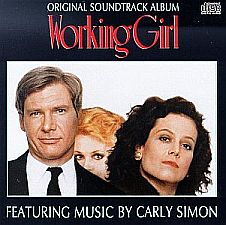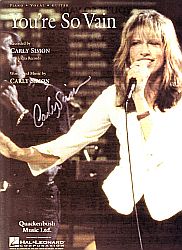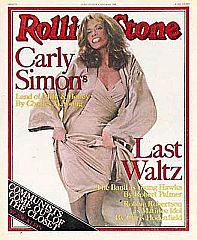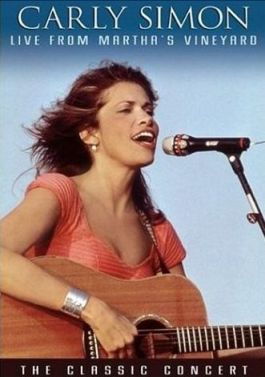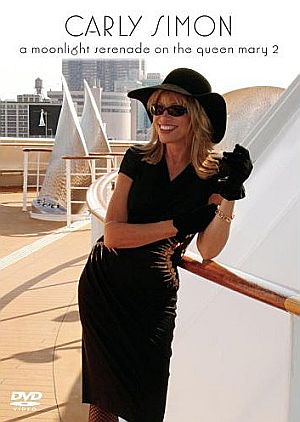
‘Let The River Run,’ by Carly Simon – from the movie ‘Working Girl’ – won an Oscar, two Grammys, and a Golden Globe. Arista single cover, 1989. Click for CD or vinyl.
In 1988, Mike Nichols, director of films such as The Graduate (1967), Carnal Knowledge (1971), and Silkwood (1983), asked Simon to score the music for a new film he was working on — a film that would become Working Girl, starring Melanie Griffith, Harrison Ford, Sigourney Weaver, and Joan Cussak.
This would be the second time in her career that Carly Simon would write music for a Mike Nichols movie. Two years earlier, in 1986, Simon had written “Coming Around Again” for the Nichols’ film Heartburn, based on the Nora Ephron book. A strong audience response to that song led to its release as a single, becoming one of Simon’s biggest hits.
In Working Girl, Melanie Griffith, the film’s central character, plays a smart, but stuck-in-a- dead-end-job secretary, who later rises to the top with a good idea despite various foils along the way. As the story unfolds, the music becomes a key part of the set up and compliments the film’s message, lingering in effect for many viewers long after the film’s showing
Simon would later explain that working on the film score took her the better part of 1988. The result was not disappointing. “Let The River Run” became the film’s signature song. She wrote it initially as the film’s opening theme. Mike Nichols liked the song from the time he first heard it. “Mike was ecstatic about it right from the beginning,” Simon would later say. However, studio executives at one point threatened to replace it with “Witchy Woman,” a song made famous by the rock group The Eagles. But Nichols wanted Simon’s song and his choice prevailed — to the benefit of film, viewers, and listeners. Simon’s uplifting tune fit the mood of the film quite well, complimenting the “working girl’s” rise to the corner office and getting her due.
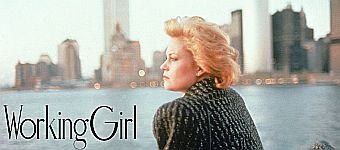
Melanie Griffith, in character, on her work-a-day ferry ride to the 'Wall Street jungle' in 1988's 'Working Girl'. Click for Blue Ray or DVD.
Music Player
“Let The River Run”
In a February 1989 story by Stephen Holden of the New York Times, Simon noted that the song was partly inspired by the movie’s New York city shooting script:
“The opening sequence was so grand with its images of the Hudson River, the Statue of Liberty and the gleaming steel buildings that it seemed to call up a Walt Whitman feel. …I looked through ‘Leaves of Grass’ [Whitman’s famous poem] and though I couldn’t find what I wanted, the poetry helped me get toward the feeling I wanted. From the beginning, I thought it should be a hymn with a jungle beat. To me, there was something very grand yet jungle-like about the story of these naive secretaries going every day into the Wall Street jungle.”
…The song started with a different title. “First it was ‘The Wall Street Hymn,’ then it was ‘The New Jerusalem.’ That was originally a throwaway line I thought I’d change, but I kept it because it gave New York an aura of holiness, as though it were the promised land.”
Working Girl became the feel-good movie of the year, and Simon’s theme a kind of anthem for working women everywhere. The song also became a moderately successful single on the Billboard music charts in early 1989 — it peaked at No. 49 on the Billboard Hot 100 and No. 11 on the Adult Contemporary chart.
Simon and the song also picked up some prestigious awards — winning an Oscar for Best Song of the year, a Golden Globe for best original song (1989), and a Grammy for best song written for a motion picture or television (1990). And in making that trifecta, Simon became the first artist to win a Grammy, an Oscar, and a Golden Globe for a song composed, written, and performed entirely by a single artist.
But beyond the awards, “Let The River Run” has also inspired praise and comment from a number of listeners — those who saw the film and others who just liked the music.“. . .[I]t’s one of the songs I listen to when I need to get fired up….”
– Carly Simon fan. “I have a strange obsession with the song ‘Let the River Run’ by Carly Simon,” wrote one male blogger from Alaska in 2004. “…I know I probably shouldn’t admit this, but it’s one of the songs I listen to when I need to get fired up…. I listen to it before I might have a date or before an exam or before a job interview….it just gets the blood pumping better than some of the stupid dance music I usually listen to…” Another male fan from Ballston Lake, New York, writing to Simon at her website in 2003, noted: “I picked up your Anthology CD set for one song, ‘Let the River Run.’ I rarely buy CD’s, but this song speaks to my soul….Your song speaks of SO much truth, it really is ‘in the asking’! … I love it!” Beyond her own website, there are other music sites that also offer listener comment on this song with similar results — i.e., “powerful,” “uplifting,” “positive song!”, etc.
There is also something deeper about this song, not necessarily stated in the lyrics, but more between the lines; a kind of emotional subtext – a feeling about the immigrant experience generally and historically; and a paying homage to that process and the rising of the nation from it. And also, on a personal level, this music celebrates the rising of any soul doing his or her best in the process of daily living; in the struggle to move forward.
|
“Let the River Run” Let the river run, Silver cities rise, It’s asking for the taking. We’re coming to the edge, We the great and small It’s asking for the taking. Oh, my heart is aching. It’s asking for the taking. We’re coming to the edge, Let the river run, |
Carly Simon
Carly Simon, born in 1945, was raised in a well-to-do family where the likes of Rogers and Hammerstein dropped by for dinner. “George Gershwin came by our house the year that Porgy and Bess came out and he played songs for my mother and father,” she explained in one interview. Her father, Richard Simon was a founder of New York’s Simon and Schuster publishing house, though Carly remembers that he was at his best on the piano. Her father died when she was 15. She attended private schools and traveled abroad at a young age. Still, she did not have an automatic or gilded rise to recording success in the music business. As a child, to about age 10, she had something of serious stutter, and had difficulty getting a sentence out without stammering. But her mother would say, “sing it, Carly,” and she did — without the stammer. With the singing technique she eventually overcame her stammering.
Sister Act
As a teen, she and older sister Lucy taught themselves how to play guitars and began singing together, forming a duo. They hitch-hiked to some early gigs in Provincetown, MA. In March 1964, Carly and Lucy, appeared on the ABC’s Hootenanny variety show. Carly was then in college at Sarah Lawrence. The sisters had one minor hit, signed a record contract, and played more live performances.
“…We played the Bitter End and the Gaslight clubs in Greenwich Village, opening for Woody Allen, Bill Cosby, Dick Cavett and other soon-to-be-famous people,” recalls Carly on her website. “We wore matching dresses and caught the train, very late at night, back to our schools in the private sector.” The sisters disbanded their act when Lucy married. Carly dropped out of Sarah Lawrence and by 1968 was on her own in New York, working at part-time jobs.
New York
In New York she worked with various musicians, among them, Mike Bloomfield, Al Kooper, and others who would become known as The Band. She was also writing songs at that point, hoping to gain exposure if not a few bucks through publishing rights. At one point she had sent four of five of her songs out to Dionne Warwick, Cass Elliot, Burt Bacharach, and Judy Collins. But no luck. She bounced around a bit more, found a manager, and was given a shot at Elektra records, signing a contract in 1970.
Her first hit song, which she also wrote, came in the summer of 1971 — “That’s The Way I’ve Always Heard It Should Be” — which rose to No.10, and was also on her debut album, Carly Simon. That album was followed quickly by a second in November 1971, Anticipation, a bestseller with a hit single of the same name, reaching No.13. Simon, meanwhile, won that year’s Best New Artist Grammy.
Her big break-out hit, however, came in 1972 — “You’re So Vain” — which hit No. 1 on the U.S. charts and sold nearly two million copies in the U.S. alone. The song helped move the album No Secrets, also No.1 for six weeks. At the Grammys, “You’re So Vain” received three awards, including those for Best Record and Best Song of the year.Much of Simon’s music is autobiographical and personal; about her love life and personal experiences. Simon had relationships with, among others: Cat Stevens, Warren Beatty, Mick Jagger, Kris Kristofferson, Keith Hernandez, and singer songwriter James Taylor.
In November 1972, she and James Taylor married; two children followed in 1974 and 1977. Simon and Taylor sang some songs together, and their 1974 duet, “Mockingbird” hit No. 5. For a time, they were seen as “the golden music couple.” Simon also scored big with her own 1974 song, “I Haven’t Got Time for the Pain.” And other opportunities also came Simon’s way.
Bond Hit & No Nukes
“One snowy day in late ’76 Marvin Hamlisch called and asked if I would listen to a song he and Carole Bayer Sager had written for the new James Bond movie, The Spy Who Loved Me,” writes Simon on her website. “It had been a lifelong dream of mine to sing a song for a movie. I had done this many times as a young girl with only a mirror recording my movements…” The song she recorded for the Bond film in 1977 — “Nobody Does It Better” — became a big hit, reaching No. 2 on the pop charts and No. 1 on the Adult Contemporary Chart for seven weeks. It was followed in 1978 by another hit, “You Belong to Me” reaching No. 6 on the charts.
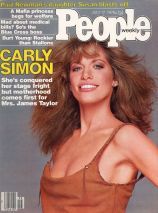
People cover, July 17, 1978.
In 1995, Simon began touring again for the first time in 14 years. In fact, in April of that year, she surprised thousands of commuters at New York’s Grand Central Terminal with an unannounced concert there that was filmed for a Lifetime Television Special and later released in home video. She also toured that year in some 16 cities with Hall & Oates, and in late August 1995, made a rare joint appearance with her ex-husband, James Taylor at a Martha’s Vineyard benefit concert.
In 1997 Simon was diagnosed with breast cancer. After undergoing a mastectomy, chemotherapy, and reconstructive surgery she went back to work and wrote and recorded The Bedroom Tapes, which include personal songs such as “Scar” that dealt with her cancer ordeal. In 2001, Simon performed on a song with Janet Jackson on Jackson’s album All for You and she also contributed back-up vocals for two songs on Mindy Jostyn’s 2001 album Blue Stories.
|
Carly Simon 1971 “That’s the Way I Always |
Since then Simon has continued to write, record, and perform on her own. In 2004, her fourth greatest hits album, Reflections: Carly Simon’s Greatest Hits, peaked at No.22 on the Billboard charts that year. In 2005, she released her fourth album of standards, Moonlight Serenade, which reached No.7 on the Billboard Album charts, also performing two concerts onboard the Queen Mary II cruise ship to promote the album, released on DVD in 2005. The following year, an album of covers, Into White, included songs from Cat Stevens, Judy Garland, The Beatles and the Everly Brothers, as well as two of her own new songs. This album also features collaborations with her adult children, Ben and Sally, also recording artists. In March 2008, Simon signed with the Starbucks record label, Hear Music, producing the album, This Kind of Love. Another album with Iris Records, reworking many of her classic songs, is being planned for late 2009.
In 1994, Carly Simon was inducted into the Songwriters Hall of Fame. Since 1971 when she made her debut album, Simon has released more than 30 albums and compilations. She has had several million-selling singles and albums and has written and composed popular film songs. Her music has reached tens of millions around the world. A more detailed and autobiographical accounting of Carly Simon’s music and career is found at her website. Additional sources are also provided below.
For other stories at this website see, for example, “Noteworthy Ladies,” a topics page offering a selection of stories on notable women and their careers, including: writer and ecologist Rachel Carson and her book, Silent Spring; Olympics star and pro golfer, Babe Didrikson; singer and TV celebrity Dinah Shore; rock star Tina Turner; and Hollywood dancer/movie star, Cyd Charisse. Thanks for visiting – and if you like what you find here, please make a donation to help support the research and writing at this website. Thank you. – Jack Doyle
|
Please Support Thank You |
________________________________
Date Posted: 31 August 2009
Last Update: 22 February 2019
Comments to: jackdoyle47@gmail.com
Article Citation:
Jack Doyle, “Let The River Run, 1988-1989,”
PopHistoryDig.com, August 31, 2009.
________________________________
Sources, Links & Additional Information
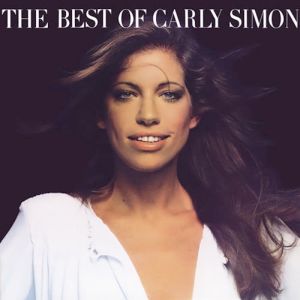
Carly Simon’s 1st greatest-hits compilation, released in November 1975, covers her 1971-1975 songs. Click for CD.
“Carly Simon,” in Holly George-Warren and Patricia Romanowski (eds), The Rolling Stone Encyclopedia of Rock & Roll, Rolling Stone Press, New York, 3rd Edition, 2001, pp. 883-884.
Don Heckman, “Carly Simon Sings At the Bitter End; She’s Flying High,” New York Times, Saturday, December 18, 1971, p.35.
John Rockwell, “Carly Simon–The Fans Don’t Scare Her Anymore; Carly Simon Is Performing Again,” New York Times, Sunday, June 12, 1977, Arts & Leisure, p. 69.
Stephen Holden, “Carly Simon’s Emotion-Laden Self-Portrait,” New York Times, Sunday, May 3, 1987.
Stephen Holden, “The Pop Life,” New York Times, Wednesday, February 22, 1989.
Todd Leopold, “Carly Simon Bares Her Soul; Singer-Songwriter Returns with Anthology, Christmas Album,”CNN.com, Entertainment, November 26, 2002.
CNN, People in the News, “Paul Zahn Interview With Carly Simon,” CNN, May 8, 2004.
“Artist Biography — Carly Simon,” Billboard Magazine.com.
“Carly Simon,” Wikipedia.org.
Janet Maslin, “Heroines in the Footlights, From All Sides Now,” [ Book Review of Sheila Weller, Girls Like Us: Carole King, Joni Mitchell, Carly Simon and the Journey of a Generation, Atria Books, 2008, 584 pages], New York Times, April 17, 2008.
Stephanie Zacharek, Book Review, “Natural Women: The Lives and Times of Carole King, Joni Mitchell & Carly Simon,” New York Times, April 27, 2008.
“Carly Simon Signs With Starbucks’ Hear Music,” Rolling Stone, February 29, 2008.
